|
ADA CIGANLIJA UNDER ICE
Somehow, after a warm summer season, we always look forward to cold winter days. You might ask now "what does diving
have to do with winter"? and you would be surprised – it has a lot. ICE DIVING is a very attractive way of diving and
only the chosen few have the opportunity to try it at least once in their lifetime.
In order to grasp the seriousness of such dives, we will first explain to you what happens to a human being so
unfortunate to fall into the ice-cold water. With this text we will try to clarify some doubts regarding this subject.
By "cold sea" we consider a sea whose temperature is below 30°C. HYPOTHERMIA is defined as a body core
temperature less than 35 degrees Celsius. Hypothermia is also considered the clinical state of sub-normal
temperature when the body is unable to generate sufficient heat to efficiently maintain functions. Many variables contribute
to the development of hypothermia. Age, health, nutrition, body size, exhaustion, exposure, duration of exposure, wind,
temperature, wetness, medication and intoxicants may decrease heat production, increase heat loss, or interfere with thermostability.
It is known that there is a direct dependency between blood-heat and metabolism.
The decrease in blood-heat for only 1°C causes reduction of our metabolic functions for 20%. Since
water transmits heat almost 27 times more strongly than air, the process of body core temperature dropping is very fast. According to some researches, the majority of the cooling happens through our face (50%-70%).
The body loses heat to the water about 30 times faster than in air. The loss of body core temperature in the water is approximately 150 times bigger than on the same air temperature. This ratio is even bigger when the body is moving i.e. when we swim or have cold water flow around us. The abovementioned speed is not only dependent on water temperature but also on our physical condition and our personal resistibility to low temperatures. Corpulent people have much better resistibility to low temperatures than thin people.
|
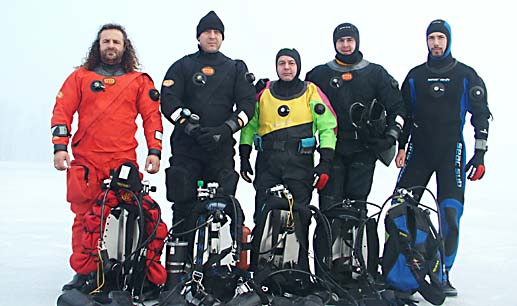
|
We can split the process of body cooling into 4 gradual phases. At the beginning – during
the first phase, body reacts by increasing heat emission, visible only through changes on our skin – goose bumps – and the increase in our pulse. During
the second phase there is actual body cooling occurring which leads to centralization of our blood stream with the increase in our mid arterial pressure leading to coronary insufficiency. Our pulse weakens because the amount of blood circulating is decreasing. As a result, heart arrhythmia occurs and, with the further drop of temperature becomes more severe. Now, although all of these changes happened, our organism is still in a relative balance and all of these functions can easily reverse at any moment. The face of a person in this condition has certain characteristics: eyes fall in, pupils are wide, lips are bluish and skin pale.
|
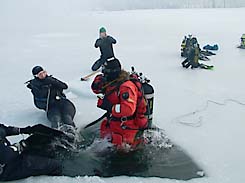
|
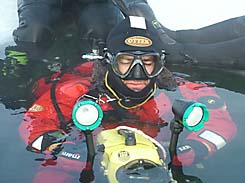
|
With the further drop of body core temperature to 32°C the third phase
starts and this one in not always reversible. Shivering slows or stops, muscles begin to stiffen and mental confusion and apathy sets in. Speech becomes slow, vague and slurred, breathing becomes slower and shallow, and drowsiness and strange behavior may occur.
The forth phase or Severe Hypothermia: Core temperature now below 31 degrees Celcius.
Skin is cold, may be bluish- gray in color, eyes may be dilated. The victim is
very weak, displays a marked lack of coordination, slurred speech, appears
exhausted, may appear to be drunk, denies problem and may resist help. There is
a gradual loss of consciousness. There may be little or no apparent breathing,
the victim may be very rigid, unconscious, and may appear dead.
|
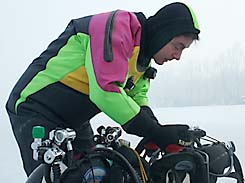
|
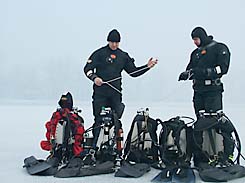
|
However, the encouraging fact is that the recovery is recorded
even with the drop to 24°C. Be aware that hypothermia may masquerade as a
variety of conditions, including death, in a variety of situations and seasons.
It is encouraging that some experiments on
animals confirmed that even after 30 minutes in the state of
severe hypothermia, it is possible with the proper
reanimation to recover almost all vital functions. We should
always act on the premise that "no one is dead until warm
and dead". The patient is cold, stiff and cyanotic, with
fixed pupils and no audible heart tones or visible thoracic
excursions have been successfully resuscitated. One patient
recovered completely in the morgue. The only certain
criterion for death in hypothermia is irreversibility of
cardiac arrest when the patient is warm.
|
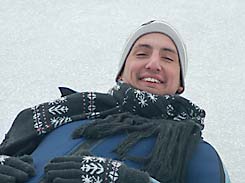
|
The cause of death during hypothermia cannot be not easily established or explained since it also depends on the speed and the way the body core temperature dropped and some other factors, too. For instance, death by falling into cold water can be caused momentarily due to the shock in between 1 and 3 minutes or due to the coronary arrest. With gradual cooling, the cause of death can be a cessation of vital functions, cardiovascular in the first place. The below table shows us the timings for survival in cold water and the graph shows the consequences of body core temperature decrease.
We suggest you take a good look at this table:
|
Temperature in oC |
Loss of
consciousness after: |
Approximate
survival time |
|
Less
than 2o |
15
minutes |
Less than
¾ sata |
|
2o to
4o |
30
to 45 minutes |
Less than 1 sata |
|
4o to
10o |
1 – 2
hours |
Less than 3 sata |
|
10o to
15o |
3 – 4 hours |
Less than 6 sati |
|
15o to
20o |
4 – 7 hours |
Less than 12 sati |
|
Above 20o |
18 – 24 hours |
Indeterminately |
|
38°C
|
obvious shiver
|
|
36°C
|
confusion
|
|
34°C
|
disorientation, memory loss |
|
32°C
|
heart slowing down and beating irregularly
|
|
30°C
|
muscles become tense, pupils tighten
|
|
28°C
|
muscles loosen up
|
|
26°C
|
virtual death
|
|
24°C
|
death
|
ICE DIVING is very demanding and requires, most of all, skilled divers and longer preparation.
This year we had ideal
conditions to prepare on time for these “ice dives” because
the temperatures dropped no sooner than the end of January.
We started preparing for cold-water dives at the end of the
summer by setting a polygon in the lake and then organized
dives 2-3 times a week. The team was set and the months went
by in the expectation for the lake to freeze. Finally, The
Day came. Ada froze and we enthusiastically organized a
meeting and prepared the team for the night dive.
It was -5oC and
water temperature was 2oC, so it was a bit
insecure to wonder about the ice that was not completely
set.
It was the first night ice
dive for some members of the team and for some, the first
ice dive ever. We split the team into two groups and began
with our dive plan. We dug up a triangle hole in the ice to
make it easier to enter and the first group went below the
ice. Members of the second group paid close attention to the
bright lights under the ice. And, after about 20 minutes,
they started to approach the hole. Their dive was coming to
an end. Slavica was the first to emerge and she couldn’t
have hidden her delight. There was no way she could have
expressed it in words so she just waved her head with joy.
|
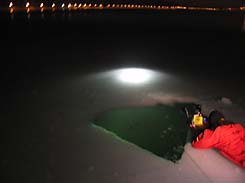
|
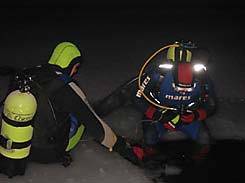
|
The second group
was ready for the dive and, after a couple of minutes they disappeared under the
ice. Once you start descending into the darkness, your concentration is on its
max and you almost can’t feel the cold, especially if that is your first ice
experience. The ice was about 10 cm thick and it was impossible to push through
the ice underwater, meaning you could have only exited through the hole you went
into the lake in the first place.
The group leader was tied
with the rope and he was the only one with the direct
contact with our backup on the surface. We had buddies below
roped up together in order to reduce the risk of anyone
getting lost. The procedures were set as well as
signalization, both manual and with lights. We were ready
for the dive.
Looking at out students, we
realized they were up to the task. Once we entered the
water, all fear from their eyes disappeared. Trust in the
group leader as well as self-confidence and knowledge they
acquired took over any trace of panic or second thoughts
they might have had.
Think for yourself, while
reading this article, who would you trust with your life so
easily???
Spending minutes facing the ice and crawling
underneath it, you are in for the best relaxation of your life. Nothing will be
more important than those moments, the time will stop and all of your problems
will dilute in the beauty of the experience. Your thoughts will be preoccupied
with the sites of different shapes that air forms underneath the ice. After you
exit ice-cold water, you’ll have a different perspective on life, you’ll learn
to appreciate your health and your luck and you’ll never be the same again. Ice
diving is, as one of the most famous scuba divers once said, “a positive mental
change.”
Emerging from the water, not feeling the cold,
happier and livelier than ever, you’ll leave the frozen lake with remorse
because the peace and the experience of your ice dive will follow you throughout
your lifetime.
Day Dive
It is Sunday, a favorite day off. The temperature dropped to -15°C. It is foggy, the snow is about 40 cm high and we are getting ready for the dive. We meet at 8:30 am at our usual meeting spot. The first thought that comes to mind is that Ada is dreamlike. The ice is over 15 cm thick. The same rules apply today with the exception of extra caution while entering the water because our regulators can freeze instantly. We mustn’t wet the equipment before we go in
With the sense of urgency, we dig the triangle hole. It is so cold, our eyes hurt. A part of the group is still in their cars enjoying its warmth before they hit the ice. The first group is ready for the dive.
It only takes the jump into the water and the dive can begin.
Unlike the night dive, visibility is great and the experience is completely different. I’m not sure whether it is more claustrophobic during the day or at night, when you can’t see what is above your head.
We are enjoying ourselves so much that no one wants to go out. The second group is already getting angry because they can’t go in before we emerge so we need to get back. After a few minutes at -15 in our wet suits, many realize what icy means since everything on you just freezes, your inflator, your regulator, your BCD, and if you don’t react quickly and go to your car, the consequences can be devastating. You can’t imagine how good a feeling it is changing in the warmth of your car.
The second group finishes their dive as delighted as we were. The fog clears and sun appears. Packing my gear up, I suggest we all go for a warm cup of coffee or tea in a nearby café. Mirko’s encouraging smile shows me he’s thinking the same. The team is half frozen but happily follows our lead. The rare guests look at us with horror on their faces and so our Sunday morning socializing begins…..with the hot tea. Fortunately, soon you forget about the coldness and keep just the good memories and the unforgettable ice dive on Sava Lake.
|

